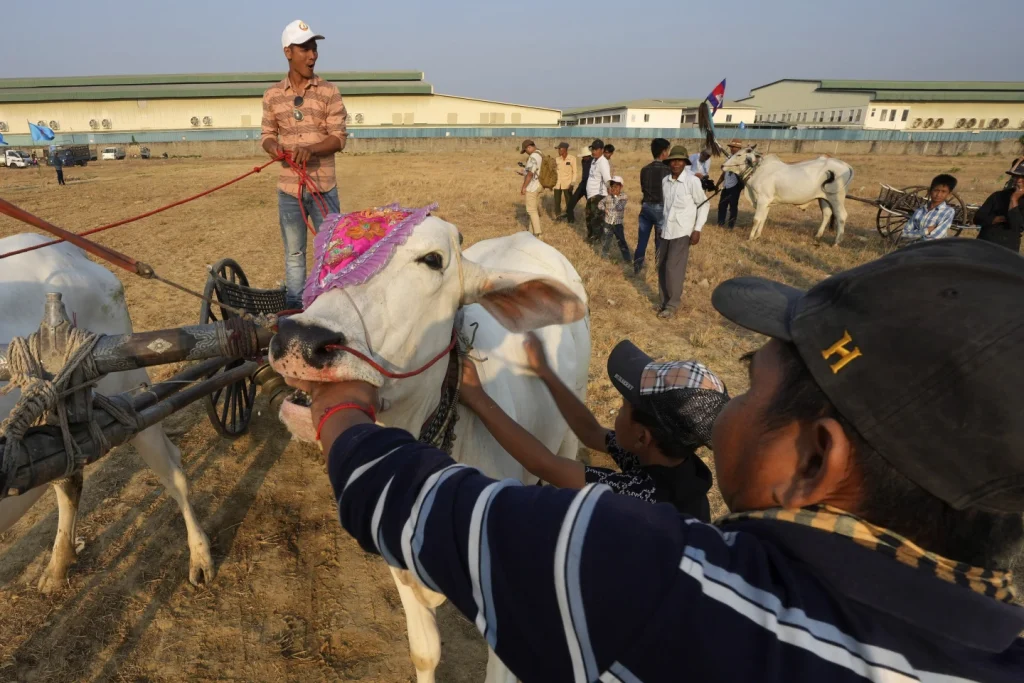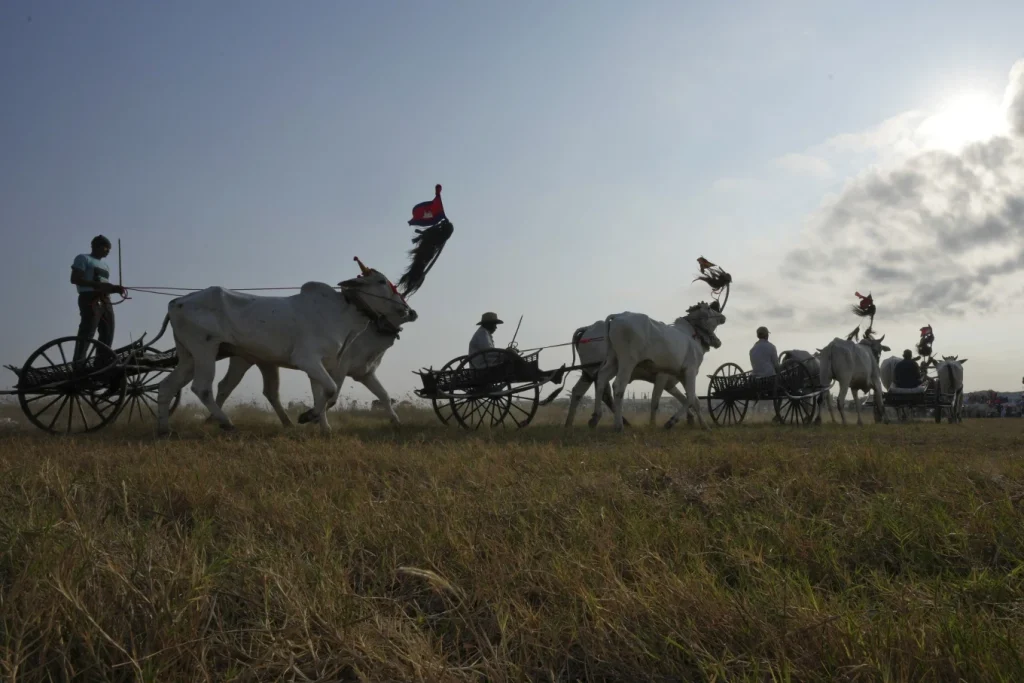In the quaint village of Romduol in Cambodia, a remarkable event unfolded on a scorching Sunday afternoon, as hundreds of villagers came together to partake in a time-honored tradition—the oxcart race.
This rare spectacle served as a poignant reminder of a centuries-old custom, symbolizing the vibrant cultural heritage deeply rooted in the hearts of the Cambodian people.
Against the backdrop of the Khmer Lunar New Year celebrations, the race not only showcased the spirit of unity and festivity but also paid homage to the conclusion of the arduous rice harvest, a pivotal moment in the agricultural calendar.
Nestled in the Kampong Speu province, a mere 40 kilometers away from the bustling capital city of Phnom Penh, Romduol village became the focal point of this exhilarating event.
The dusty terrain bore witness to the fervor and excitement that enveloped the participants and spectators alike, as they eagerly awaited the commencement of the race.
The rhythmic clatter of hooves and the resounding cheers of the onlookers created a symphony of sights and sounds that resonated throughout the village, infusing the atmosphere with an infectious energy.

Amidst the sweltering heat, the contestants embarked on their journey, seated atop oxcarts drawn by sturdy oxen, navigating a challenging 1-kilometer dirt track with skill and precision.
The spectacle of fifty pairs of oxcarts from diverse provinces—Kampong Speu, Kandal, Phnom Penh, and Kampong Cham—engaged in a friendly yet competitive race, captivated the audience and encapsulated the essence of camaraderie and sportsmanship.
Each cart, a symbol of tradition and heritage, carried with it the collective memories and aspirations of a community deeply connected to its roots.
However, beneath the veneer of celebration and nostalgia loomed a poignant reality—the gradual decline of the oxcart, an iconic mode of transportation synonymous with Cambodia’s rural landscape.
In an era dominated by tractors and motorized rickshaws, the oxcart stands at the precipice of obscurity, its significance fading with each passing day.
The race, therefore, served as a poignant reminder of the need to preserve and safeguard these cultural artifacts, ensuring that future generations inherit a legacy rich in history and tradition.
For Khem Rithy, a 40-year-old teacher from Kampong Speu provincial high school, witnessing the oxcart race was a transformative experience.
Accompanied by 150 students, he embarked on a journey that transcended mere spectacle, delving into the heart of Cambodian heritage and identity.
As the cheers reverberated around him and the oxcarts thundered past, Khem Rithy found himself immersed in a tapestry of sights and sounds that spoke volumes about the resilience and spirit of the Cambodian people.
In conclusion, the oxcart race in Romduol village stands as a testament to the enduring legacy of Cambodian culture—a vibrant tapestry woven with threads of tradition, community, and resilience.
As the sun set on this momentous occasion, casting a golden hue over the dusty landscape, it illuminated not just a race, but a journey—a journey that transcended time and space, bridging the past with the present and inspiring hope for the future.
May the spirit of the oxcart race continue to thrive, serving as a beacon of tradition and unity for generations to come.

In the quaint village of Romduol in Cambodia, a remarkable event unfolded on a scorching Sunday afternoon, as hundreds of villagers came together to partake in a time-honored tradition—the oxcart race.
This rare spectacle served as a poignant reminder of a centuries-old custom, symbolizing the vibrant cultural heritage deeply rooted in the hearts of the Cambodian people.
Against the backdrop of the Khmer Lunar New Year celebrations, the race not only showcased the spirit of unity and festivity but also paid homage to the conclusion of the arduous rice harvest, a pivotal moment in the agricultural calendar.
Nestled in the Kampong Speu province, a mere 40 kilometers away from the bustling capital city of Phnom Penh, Romduol village became the focal point of this exhilarating event.
The dusty terrain bore witness to the fervor and excitement that enveloped the participants and spectators alike, as they eagerly awaited the commencement of the race.
The rhythmic clatter of hooves and the resounding cheers of the onlookers created a symphony of sights and sounds that resonated throughout the village, infusing the atmosphere with an infectious energy.
Amidst the sweltering heat, the contestants embarked on their journey, seated atop oxcarts drawn by sturdy oxen, navigating a challenging 1-kilometer dirt track with skill and precision.
The spectacle of fifty pairs of oxcarts from diverse provinces—Kampong Speu, Kandal, Phnom Penh, and Kampong Cham—engaged in a friendly yet competitive race, captivated the audience and encapsulated the essence of camaraderie and sportsmanship.
Each cart, a symbol of tradition and heritage, carried with it the collective memories and aspirations of a community deeply connected to its roots.
However, beneath the veneer of celebration and nostalgia loomed a poignant reality—the gradual decline of the oxcart, an iconic mode of transportation synonymous with Cambodia’s rural landscape.
In an era dominated by tractors and motorized rickshaws, the oxcart stands at the precipice of obscurity, its significance fading with each passing day.
The race, therefore, served as a poignant reminder of the need to preserve and safeguard these cultural artifacts, ensuring that future generations inherit a legacy rich in history and tradition.
For Khem Rithy, a 40-year-old teacher from Kampong Speu provincial high school, witnessing the oxcart race was a transformative experience.
Accompanied by 150 students, he embarked on a journey that transcended mere spectacle, delving into the heart of Cambodian heritage and identity.
As the cheers reverberated around him and the oxcarts thundered past, Khem Rithy found himself immersed in a tapestry of sights and sounds that spoke volumes about the resilience and spirit of the Cambodian people.

In conclusion, the oxcart race in Romduol village stands as a testament to the enduring legacy of Cambodian culture—a vibrant tapestry woven with threads of tradition, community, and resilience.
As the sun set on this momentous occasion, casting a golden hue over the dusty landscape, it illuminated not just a race, but a journey—a journey that transcended time and space, bridging the past with the present and inspiring hope for the future.
May the spirit of the oxcart race continue to thrive, serving as a beacon of tradition and unity for generations to come.

